




| The Flying 4x4
A more streamlined lumber rocket |
If you wish to skip the verbose narrative,
here are links to data for each launch: Flight 1 Flight 2 Flight 3 Flight 11 |
Rambling Narrative:
I complained that the 2x4s were not stable in flight.
Sometimes they flew beautiful ballistic patterns, more often they corkscrewed their way through thick air and didn't go very far.
Girlfriend said "put fins on them." I laughed. How could I put fins of any significance on a 2x4 and still launch it from a 4-inch PVC pipe? Guess I could put lugs on it and launch it from my 1/2 inch rod, but the rod is only 6 feet long and the 2x4 is 8.
Then a flash! If I took a piece of 4x4, carved a "nose cone" on one end and drilled a hole for the engine on the other, it would accept fins and launch lugs easily. But Home Deep Hole did not have anything that would drill a 2-inch hole 7 inches into wood. No 2 inch spade bit. There was a $30. set of Forstner bits including a 2-incher, but the shaft was only 5 inches long. A hole-saw would only go in 2 inches and would leave a plug in the way.
Girlfriend said: What if you split the 4x4 in half, carved it out, and screwed it back together?
Out of the mouths of babes. Uh... babies? No, no, I am sure it was "babes." PC breaks down. Teresa doesn't mind.
Refreshing to be with a woman who is smarter than I am. Now I can be incompetent for awhile, right?
Not for long. My turn for a minor stroke of genius: I don't have to rip a 4x4, Homer has done that for me. I just cut a 2x4 in half, use a router to carve half of an engine bay on each piece, and mate the halves together with long drywall screws.
Fins are easy, since there are 4 flat sides. I just cut a simple, generous shape from 1/4 inch plywood and screw one on each side. Not going to a lot of trouble to finish these, as I expect some of them to break on each shot.
Nose "cone" is Mummy style.
Here is the result, hanging in the balance. Without engine it weighs 9.25 pounds.
What appears to be a cool insignia on the front end is just a spot where I had glued an engine for a 2x4 shot. Yes, this is veteran wood. Nothing virgin about it. I chiseled off most of the glue and sanded off most of the splinters.
Here it is sitting on the pad, nestled with the launch-rod. And posed with my new bicycle, for scale. Great for skimming over the meadow muffins. The bicycle, I mean, not the rocket.
Here is the setup with the camera in place, the inscribed PVC measuring-pole, and the rocket on its launcher in the distance. Hey, where's the camera? Oh. It's in my hands, taking this picture.
Now you can see a big secret: my "launch controller" is a power-strip with an on/off switch. Cheap. Works. Makes a loud click that I can see in the .wav file and know exactly when power was applied.
How many fins am I going to lose on this flight?
Time to place your bets.
My odds are:
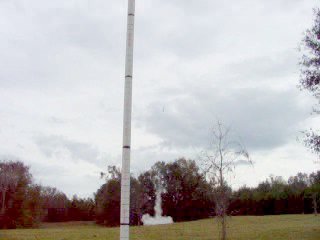
Click here to download a video of this
launch.
Beware: This is a 1.5 meg file, 8.5 seconds of video
Click here for data analysis of this launch
(includes link to video)
The answer: none of the above!
It plowed straight into about 10 inches of dirt. Surprisingly, the nose is not damaged. But the extension cord looks a little nervous.
Flight 2 Prep
12-23-01b
Pulled out the fired engine, assembled a new one, and it is ready to go again. This time with a bit less fuel. Its nose is dirty, but still proud.
Not a bad photo of the launch setup. Hey! Where's my camera? Oh. It's in my hands, taking this picture.
Flight 2 Launch
12-23-01b
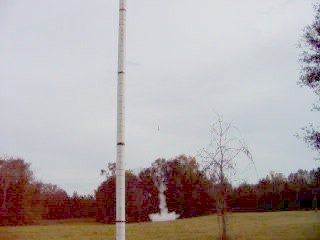
Click here to download a video of this
launch.
Beware: This is a 1.1 meg file, 7 seconds of video
Click here for data analysis of this launch
(includes link to video)
Didn't stick in as pretty this time, but all four fins are intact.
Flight 3 Prep
12/24/01a
Oops - forgot the tripod! Good thing I have this new bike. I made the mistake of leaving Teresa with the camera. She took some artsy shots of me and the bare trees, so I will have to take a few of her.
Flight 3 Launch
12-24-01a
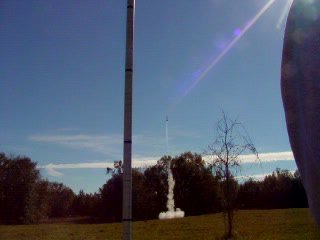
Click here to download a video of this
launch
Beware, 1.5 meg file for 9 seconds of video
Click here for analysis of this launch
(includes link to video)
Flight 4 Launch
12/25/01a
Same engine, now loaded with 143 grams of KN/sucrose in a single uninhibited grain.
Let's take that fin quiz again: How many will be lost on impact?
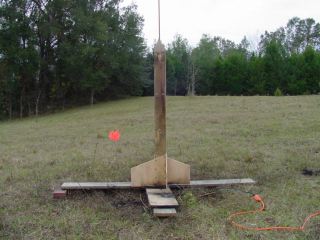
Click Here to download a video of this
launch
(660k file, 4 seconds of video)
How many fins were lost on impact? None! Didn't get a chance
- CATO on launchpad, and all fins were relocated.
Now I know how much fuel this engine can't handle.
Well, I am surprised that it lasted this long, just didn't think it would end this way.
That was successful enough to justify making another one. And I happen to have some more veteran lumber lying around.
Flying 4x4 II
The new one looks just about like the old one, especially since I re-used the old fins. Good thing about all those short little screws - when the wood under them exploded, they let go.
I have launched these vehicles 12 times as of today, with a couple more tests scheduled for tomorrow.
Flying 4x4, Flight 11
12-30-01b
Today's first shot is a classic
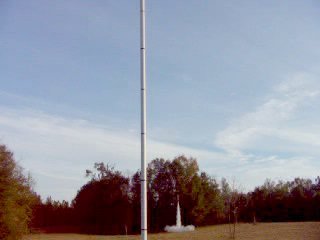
Click on the photo to visit the data page for this launch, including
link to a video of the flight
Summary:
With a more streamlined and stable vehicle, data has been much more consistent than with the 2x4 launches. I believe that the best-documented of these launches provide good estimates of the total impulse of their respective engines.
I do not suffer the delusion that this approach will replace the instrumented test stand, or that these tests can supplant static testing. On the contrary, I very much look forward to having instruments, so as to obtain much more detailed data on my engines, hopefully leading to improvements in reliability and performance.
And I look forward to comparing the data from test instruments with that obtained in these low-altitude launches. I believe that this can help validate test data in relation to real-world performance.
But the present exercise yields some results that go beneath and perhaps beyond analysis. To watch a 10 pound vehicle leap into the air attests to the power of the engine in direct and intuitive way.
The low-altitude vehicle has other advantages. It can be safely launched and retrieved in a small field such as mine. Thus it can serve as a testbed for development of other flight components such as ejection systems. Since this can be done close to home, adjustments can be made and many tests can be performed without having to drive miles from the workshop.
As larger engines are developed, heavier vehicles can be assembled to keep them within bounds. The question "how high can it go?" is still a good one. Staying low has is virtues as well.
I look forward to hearing any comments or suggestions regarding these tests.
Jimmy Yawn
12/31/01
jyawn@sfcc.net
http://user.sfcc.net/jyawn/rocketry.htm